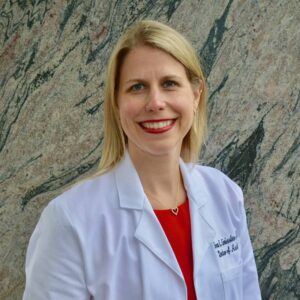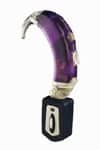Personal listening devices can improve communication with patients who aren’t already wearing hearing aids, including for audiology counseling.
By Gina Geissler, AuD, FAAA
Medical research for many years has reported patient compliance is typically 50% when it comes to listening to their doctors or healthcare professionals. Is this because patients don’t remember? Is this because they are overwhelmed or stressed with the information they are being told or simply because they cannot hear it correctly? The answer remains a mystery.
I have been a private practice doctor of audiology for over 20 years. I sincerely love my job of helping people be able to communicate to the best of their abilities. After I conduct a hearing evaluation in my office and learn that a patient has hearing loss, it has been my common practice to explain the test results and verbally talk to them about their results and make recommendations.
The irony of this situation is I am verbally giving test results and recommendations to someone I just diagnosed with a hearing loss and have documented has difficulty hearing!
We are all familiar with the PockeTalker. For years, I have occasionally used the device when I have a severe hearing loss patient who cannot hear me well. But I don’t stock or sell PockeTalkers since they are available online. I now realize I’ve been missing an opportunity to connect with patients, and they’ve been missing an opportunity to hear clearly. I recently was introduced to a new set of wireless conversation amplifying earphones and I have been so impressed with it that I have changed my counseling protocols in my office. The ClearCast PAL (personal assistive listening) device is a new FDA-registered device that has a neckband form factor and two different microphones that are useful in different settings.
Key Takeaways:
- Hearing Loss and Compliance – Many patients struggle to hear and retain medical advice, impacting their ability to follow healthcare recommendations.
- Personal Listening Device as a Solution – These devices enhance communication between audiologists and patients, improving understanding and engagement.
- Broader Benefits – Beyond medical settings, personal amplification devices help individuals hear better in daily life, strengthening relationships and emotional connections.
Improving Communication for Consultations
Now, after I finish a patient’s hearing evaluation, I immediately put the ClearCast on the patient to communicate the results to them. Even if the patient has never used a device like this before, doing so is quick, easy, and effective. I simply put the neckband around their neck and an earbud in each ear. I turn the wireless microphone on and clip it to my shirt or lab coat. Once I begin speaking, the microphone picks up my voice and immediately streams my voice directly into the patient’s ears.
There is a volume control on the neck loop that either the patient or I can very easily adjust to make it louder or softer to be most comfortable for the patient, so they can hear my voice very well. When significant others are present, I can pass the microphone to them or place it on the desk between us and it can then pick up both of our voices.
When using this personal listening device on my patients with hearing loss, I know they are able to hear me loud and clear when I’m counseling them about test results and giving recommendations for their personal hearing healthcare needs. They don’t need to have a severe hearing loss for this to be useful. Many times, patients will react with, “Wow, I can really hear you.” I simply respond, “Good, because what I need to tell you and your loved one is very important.”
I would highly recommend that all hearing healthcare practices have something like this in their office so all your patients can hear the important things you need to tell them. I have found ClearCast to be an effective and affordable medical device, but it’s just one option. A wide range of personal amplification and assistive listening devices (ALDs) are available to help patients hear, whether they have hearing aids or not. The important part is having a device available that lets your patients hear you. Research shows that when patients hear well and understand instructions, they are more likely to have better patient compliance and therefore better overall physical and mental health.
Personal Use for Home and Elsewhere
Additionally, ALDs and other devices can provide patients with some great benefits for personal use at home and in other settings where they have difficulty hearing.
For example, the ClearCast has a built-in microphone that works much like a body-worn hearing aid. And there is a second wireless microphone that can easily be worn by anyone so their voice can stream into the ears of a loved one who is hard of hearing, up to 60 feet away. It is very easy to place the microphone near the TV speaker and then the TV can also stream into the patient’s ears, giving them excellent speech clarity of what the people on TV are saying and allowing everyone in the room to listen to the TV at a comfortable volume. In a small group setting, the microphone can be placed on a table and pick up the voices of the people sitting around the table.
Who Benefits
I believe ALDs and amplification products can change the way hearing care professionals talk to and counsel their patients. I take great pride in knowing my patients can actually hear me when I am talking to them. This type of device is also a great “bridge solution” for people whose hearing is not quite as sharp as it used to be, but not significant enough where they would need or want custom hearing aids. At the 2024 AAA conference in Atlanta, it was mentioned that 70% of people that bought an OTC hearing aid had seen an audiologist prior to purchase.
Products like ClearCast allow an audiologist to provide an amplification solution to those patients who are “tested not sold” and can establish a trusted relationship that will lead to future hearing aid sales.
Elderly patients with vision or dexterity challenges are also great candidates for such devices. When patients have other medical challenges, it can make managing and maintaining custom hearing aids difficult.
The experiences of streaming TV, hearing one’s significant other well, hearing in small groups, hearing in the car, hearing their doctor, and even hearing someone down the aisle in the grocery store are all enhanced when wearing a personal listening device with a wireless microphone such as ClearCast.
Fostering Emotional Connections
Finally, when discussing end-of-life care, my experience has taught me that what people want most is to be able to say “I love you” or say their good-byes and know that their loved one heard their voice. Amplification devices and ALDs can be the answer for these extremely sensitive and emotional times. Patients in nursing homes and hospice settings could really benefit from this type of device. At the end of the day, all humans want to feel connected and heard by their friends and family, and products like ClearCast can make this possible.

Gina Geissler, AuD, FAAA, is a longtime audiologist who practices in Munster, Ind. She has worked with the inventor of ClearCast, but has no financial relationship to the company.
Featured image: ID 59931319 © Monkey Business Images | Dreamstime.com





